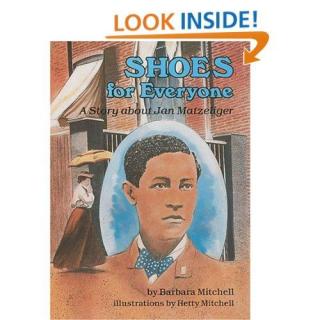GM – FBF – Today, I would like to share with you a story that many of you know about but still today as we buy or footwear do we take in mind of his Invention? Today’s controversy with Nike supporting NFL football player Colin Kaepernick and the right to protest is a far cry from what he Invented over a century ago. Enjoy!
Remember – “A shoe is not only a design, but it’s a part of your body language, the way you walk. The way you’re going to move is quite dictated by your shoes” – Jan Ernst Matzeliger.
Today in our History – September 22, 1891 – Jan Metzeliger of Lynn, MA posthumously received patent number 459,899 for improvements in the lasting machine for shoes.
Jan Ernst Matzeliger was born on September 15, 1852, in Paramaribo, Suriname—known at the time as Dutch Guiana. Matzeliger’s father was a Dutch engineer, and his mother was Surinamese. Showing mechanical aptitude at a young age, Matzeliger began working in machine shops supervised by his father at the age of 10. At 19, he left Suriname to see the world as a sailor on an East Indian merchant ship. In 1873, he settled in Philadelphia, PA.
After settling in the United States, Matzeliger worked for several years to learn English. As a dark-skinned man, his professional options were limited, and he struggled to make a living in Philadelphia. In 1877, Matzeliger moved to Lynn, Massachusetts, to seek work in the town’s rapidly growing shoe industry. He found a position as an apprentice in a shoe factory. Matzeliger learned the cordwaining trade, which involved crafting shoes almost entirely by hand.
Cordwainers made molds of customers’ feet, called
“lasts,” with wood or stone. The shoeswere then sized and shaped
according to the molds. The process of shaping and attaching the body of the shoe
to its sole was done entirely by hand with “hand lasters.” This was
considered the most difficult and time-consuming stage of assembly. Since the
final step in the process was mechanized, the lack of mechanization of the
penultimate stage, the lasting, created a significant bottleneck.
Matzeliger set out to find a solution to the problems he discerned in the
shoemaking process. He thought there had to be a way to develop an automatic
method for lasting shoes. He began coming up with designs for machines that
could do the job. After experimenting with several models, he applied for a
patent on a “lasting machine.”
On March 20, 1883, Matzeliger received patent number 274,207 for his machine. The mechanism held a shoe on a last, pulled the leather down around the heel, set and drove in the nails, and then discharged the completed shoe. It had the capacity to produce 700 pairs of shoes a day—more than 10 times the amount typically produced by human hands.
Matzeliger’s lasting machine was an immediate success. In 1889, the Consolidated Lasting Machine Company was formed to manufacture the devices, with Matzelinger receiving a large amount of stock in the organization. After Matzeliger’s death, the United Shoe Machinery Company acquired his patent.
Matzeliger’s shoe lasting machine increased shoe production tremendously. The result was the employment of more unskilled workers and the proliferation of low-cost, high-quality footwear for people around the world. Unfortunately, Matzeliger was able to enjoy his success for only a short time. He contracted tuberculosis in 1886 and died on August 24, 1889, at the age of 37, in Lynn. In 1991, the United States government issued a “Black Heritage” postage stamp. Research more about black Inventors and share with your babies. Make it a champion day!

